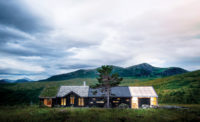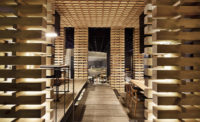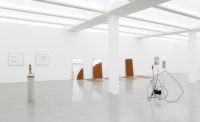Design Vanguard 2018: ibda design
Dubai

Hai D3
Photo © Sadao Hotta

Al Warqa'a Mosque
Three entryways instead of one lead to a courtyard, through which the indoor prayer hall is accessible behind a glass wall. The result, when the mosque’s wooden doors are left open, is multiple sight lines from outside the building into the sacred space.
Photo © Sadao Hotta

Beirut Museum of Art
This conceptual design uses a double-skinned ETFE facade to filter light into a museum containing indoor gardens; the scheme was driven by the Japanese word komorebi, which is the dappled effect of the sun shining through the leaves of a tree.
Photo © ibda design

Hai D3
Photo © Sadao Hotta

Hai D3
For a mixed-use office complex, the architects offer a contemporary spin on traditional elements. Here, they fashioned hollow vertical structures out of shipping containers to funnel strong desert winds downward into landscaped meeting areas and walkways, like the wind towers that once dominated Dubai’s skyline.
Photo © Sadao Hotta





Architects & Firms
Architects Wael Al Awar and Kenichi Teramoto, principals of Dubai-based ibda design, have an unusual way of communicating. Their ability to express themselves in English, their mutual language, sometimes fails them, so they resort to sketches and diagrams. Says Al Awar, “Through the drawings, the ideas become self-explanatory.”

Al Awar, 40, who is Lebanese, and Teramoto, 43, who is Japanese, met in Tokyo in 2004, when both were working for C+A, a small firm known for residential and educational projects. They landed there after Al Awar had worked in Barcelona and Teramoto in the Netherlands. Over the next seven years, as they jointly managed C+A’s projects throughout Asia and the Middle East, “our design philosophy grew closer and closer together,” Al Awar explains. So it felt natural when, after Al Awar decided to found ibda (Arabic for “start”), he asked Teramoto to join him. Teramoto didn’t hesitate: “I didn’t have any doubts,” he says.
After considering Beirut and Tokyo, Al Awar set up shop in Dubai in 2009 for a confluence of reasons— he knew several clients from previous projects; there was a flurry of development activity, but few boutique firms; and travel to Asia and other Middle Eastern countries, where they hope to expand, was easy. Teramoto moved there in 2012.
The improbability of their collaboration, and eventual location, is what makes ibda’s work unique. “There’s a heightened sensitivity in our designs to different cultures and contexts,” says Al Awar. Their approach is reflected in their process, which begins with a careful consideration of natural phenomena like daylight, the skilled labor and materials available, and historical building typologies.
In practice, this is evident in the architects’ reinterpretation of traditional elements. In a Dubai mosque, for instance, a marble and stone courtyard, which would traditionally be a private enclave, serves as a permeable transition between the street and the prayer hall, where the architects imagined kids could play soccer while adults gather. Inside the hall, the architects designed a series of skylights that allow the movement of the sun over the course of the day to alter the experience of the space. “We wanted it to have a sense of the passage of time,” says Teramoto.
Similarly, in a 145,300-square-foot mixed-use office complex, also in Dubai, the architects studied the layout of traditional Arab cities, which are characterized by buildings positioned close together to create shaded alleyways. The outcome is a series of interconnected two-story structures made of shipping containers (a nod to Dubai’s longtime status as a port city in the Persian Gulf), with public courtyards woven throughout. And for a forthcoming arts center in Jeddah, Saudi Arabia, ibda created stepped terraces and open circulation that links multiple levels through a central courtyard, effectively extending and activating the space vertically.
With each project the firm takes on, the architects blend contemporary and historical elements to create fresh designs. The results are buildings both subtly innovative yet comfortingly familiar.
ibda design
FOUNDED: 2009
DESIGN STAFF: 12
PRINCIPALS: Wael Al Awar, Kenichi Teramoto
EDUCATION: Al Awar: American University of Beirut, B.Arch., 2004. Teramoto: Tokyo University of Science, B.Arch., 1999; MS.Arch., 2001
WORK HISTORY: Al Awar: Archikubik, 2003; C+A (formerly Coelacanth and Associates), 2004–09. Teramoto: Neutelings Riedijk Architects, 2000–03; C+A, 2003–12
KEY COMPLETED PROJECTS: Yamanote Atelier, Dubai, 2016; Al Warqa’a Mosque, Dubai, 2015; Hai d3, Dubai, 2015; Omote Sando H, Tokyo, 2012
KEY CURRENT PROJECTS: Hayy: Creative Hub, Jeddah, Saudi Arabia; Beach Villa Jumeirah, Dubai; Mosque of Reflection, Dubai









